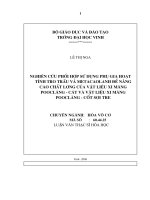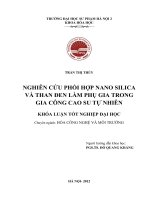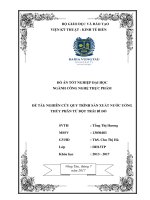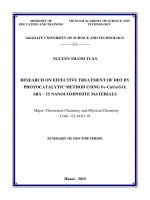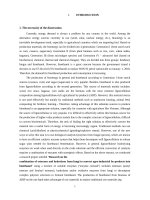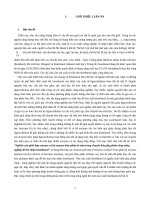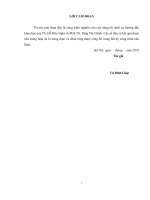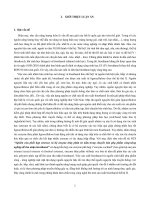Nghiên cứu phối hợp esterase và hệ enzyme thủy phân từ nấm trong chuyển hóa phụ phẩm công nông nghiệp để thu nhận bioethanol tt tiếng anh
Bạn đang xem bản rút gọn của tài liệu. Xem và tải ngay bản đầy đủ của tài liệu tại đây (570.4 KB, 29 trang )
INTRODUCTION
I.
1. The necesssity of the dissertation
Currently, energy demand is always a problem for any country in the world. Among the
alternative energy sources currently in use (wind, solar, nuclear energy, etc.), bioenergy is an
inevitable development trend, especially in agricultural countries which are importing fuel. Based on
production materials, the bioenergy can be divided into 4 generations: Generation I (from starch such
as corn, cassava, sugarcane), Generation II (from plant biomass such as rice, corn, wheat stalks,
bagasse), Generation III (from microalgae species) and Generation IV - advanced fuel (based on
biochemical, chemical, thermal and chemical changes). They are divided into three groups: biodiesel,
biogas and bioethanol. However, bioethanol is a great concern because the government issued a
decision to use E5 bio-fuel (5% bioethanol) to replace RON 92 petrol nationwide on January 1, 2018.
Therefore, the demand for bioethanol production and consumption is increasing.
The production of bioenergy in general and bioethanol according to Generation I from starch
sources (cassava, corn) and sugar (sugarcane) is very popular. Besides, bioethanol is also produced
from lignocellulose according to the second generation. This source of materials mainly includes:
wood, rice straw, bagasse, corn stalks are the biomass with the most common lignocellulose
composition among lignocellulose-rich agricultural by-products (ABP). However, this material source
is not used effectively but mainly by traditional methods such as mushroom farming, animal feed,
composting for fertilizer, burning... Therefore, taking advantage of this substrate sources to produce
bioethanol is an appropriate solution, especially for countries with agriculture like Vietnam. Although
the source of lignocellulose is very popular, it is difficult to effectively utilize this biomass source for
the production of higher value products mainly due to the complex structure of lignocellulose, difficult
to convert biochemicals. Therefore, the task of finding the right solution to effectively convert the
material into a useful form of energy is becoming increasingly urgent. Traditional methods can use
chemical (acid/alkaline) or physicochemical (grinding/explosive steam). However, one of the new
ways to solve this task is to use biological catalysts (enzymes from fungal species), which are known
to have an efficient catalytic enzyme system that helps them decompose well lignocellulose to release
sugar units needed for bioethanol fermentation. However, in general lignocellulose hydrolysing
enzymes are weak when used directly on the crude substrate and the efficient conversion of catalysts
requires a combination of enzymes with synergistic effects. Based on the above reasons, we conducted
a research project entitled "Research on the
combination of esterases and hydrolases from fungi to convert agro-industrial by-products into
bioethanol" using a mixture of suitable enzymes ("enzyme cocktail") includes esterases (acetyl
esterase and feruloyl esterase), hydrolases and/or oxidative enzymes from fungi to decompose
complex polymer structures to ferment bioethanol. The production of bioethanol from biomass of
AIBP on the one hand takes advantage of raw materials to replace traditional raw materials (eg
1
cereals, corn, cassava), on the other hand forms a clean energy source to help solve the problem of
environmental pollution caused by burning or processing according to traditional methods, and
does not affect the national food security. This is also one of the key stages of generation II in
fermentation technology of bioethanol.
2. Objectives of the dissertation
Currently, the ability to convert raw materials from lignocellulose-rich biomass by
traditional methods has many limitations. Therefore, the objective of the thesis is to exploit a
variety of biocatalysts (hydrolases) from fungi to efficiently convert lignocellulose-rich biomass
from ABP into sugars (C5 and C6) capable of fermenting for bioethanol production. The thesis
uses "enzyme cocktail" synergistic catalyst to increase the ability of biological transformation.
Therein, the study used carbohydrate esterase [feruloyl esterase (FAE), acetyl esterase (AE)] to
coordinate with main circuit attack enzymes (cellulase/xylanase) and branched circuits to
hydrolyze lignocellulose structure. In order to increase bioavailability, a second objective is to
study the use of a mixture of enzyme ("enzyme cocktail") and to assess the possibility of
converting monosaccharide into bioethanol by "enzyme cocktail".
3. Content of the dissertation
To achieve the above objectives, the main research included:
- Isolation, screening and selection of fungal strains which are carbohydrate esterase [feruloyl
esterase (FAE), acetyl esterase (AE)] biosynthesis capable.
- Biosynthesis and purification of FAE and AE from the culture medium and characterization
of purified enzymes.
- Transformation of lignocellulosic material into monosaccharide (hexose and pentose) capable
of fermentation using single enzymes and enzyme cocktails cellulase/xylanase and esterase.
- Optimizing the process of transformation and research on the production of bioethanol from
transformation process in laboratory-scale.
4. New contributions of the dissertation
- 44 species belong to Basidiomycota and Ascomycota isolated in Vietnam were screened for
their ability of carbohydrate esterase (feruloyl esterase, acetyl esterase) production.
- Feruloyl esterase from Alternaria tenuissima and acetyl esterase from Xylaria polymorpha
were firstly purified from lignocellulose-rich cultures. Of which Alt.tenuissima feruloyl esterase
(AltFAE) has molecular weight (Mw) of 30.3 kDa and specific activity of 11.2 U/mg protein. While
X.polymorpha (XpoAE) acetyl esterase has Mw of 44 kDa and specific activity of 13.1 U/mg.
These two enzymes are highly stable at temperatures of 40 to 45ºC and pH 5.0-5.5.
- Above purified carbohydrate-esterases in combination with the commercial cellulases (“enzyme
cocktail” with cellulase/xylanse activities) were compositionly optimized and used for the
conversion of the raw plant-biomass (bagasse cane, rice straw, meals wood, seaweed …) into
2
fermentable monosaccharides sugar. Of which bagasse cane was chose as the most suitable
substrate for C5/C6 monosaccharides production (glucose, xylose) with the efficiency of 49.8%
- Evaluated the ability of fermentation of enzymatically hydrolyed C5/C6-sugars to produce
bioethanol by Saccharomyces cerevisiae with the efficiency of 79.8% according to the theory.
5. The scientification of the dissertation
In addition to the production of bioethanol from starch (cassava, corn) and sugar (sugarcane),
bioethanol can be produced from lignocellulose. Lignocellulose is the most common biomass in
the biosphere. Bioethanol production from lignocellulose is a good solution especially for
countries with agriculture like Vietnam. Annual domestic agro-industry production of hundreds of
millions of tons of lignocellulose-rich by-products is an extremely abundant source of raw
materials for clean energy production, on the other hand addressing the problem of environmental
pollution caused by not being treated or exclusion by traditional methods.
Published literatures and our experience show that lignocellulase are generally weak when
used directly (not processed) on raw substrates. This can be overcome by using “enzymes
cocktail” that include hydrolase and/or oxidative enzymes so that they play an important role in
finding new enzymes with high bioactivity of complex polymeric structures. In addition to,
screening of enzymes by micro-organism culture and useful properties.
The thesis is not intended to address the whole process of converting crude biomass into
biofuel whose main objective is to exploit and use bio-diversity of fungus and optimize it for
converting biomass into sugar capable of fermenting. This is also one of the key stages of
generation II in the generation of bioethanol.
6. Dissertation frame
The dissertation consists of 163 pages with 21 tables, 58 images,143 references. The
structure of thesis: Introduction (4 pages), Chapter 1: Overview (39 pages), Chapter 2: Materials
and methods (26 pages), Chapter 3: Results and discussion: (67 pages), Conclusion (2 pages), List
of published literatures (1 page), References (13 pages), Appendix (39 pages).
II. CONTENT OF THE THESIS
The introduction discusses the scientification, novelty, mission and content of thesis.
Chapter 1. Overview
This section presents:
- An overview of lignocellulose-rich agricultural by-products (ABP), which describes the origins,
current status of ABP use in Vietnam in general and the origin, current status, environmental
issues from bagasse in Vietnam in particular.
- Transformation of lignocellulose-rich materials by biocatalysis. It highlights the mechanism of
enzyme metabolism in lignocellulose hydrolysis, enzymatic source from diverse fungi in Vietnam,
3
lignocellulose enzyme from fungus and the role of carbohydrate esterase in lignocellulose
hydrolysis.
- An overview of bioethanol production and bioethanol research and production domestically and
internationally.
Chapter 2: Materials and methods
2.1. Microorganism
- Fresh mushrooms collected from Cuc Phuong National Park (Ninh Binh) are used for fungal
isolation, screening and purification of hydrolases for research.
- Some fungal strains are colected from strains stored in the Experimental biology laboratory,
Institute of Natural Products Chemistry.
- Commercial enzymes that purified from Trichoderma reesei (carboxymethyl cellulase and
glucuronone xylanase; 1-1.6 U/mg, Cell/Xyl, AB Enzyme, Darmstadt, Germany) optimized for
pH 5.0-5.5 and temperature is 40-45ºC.
- Saccharomyces cerevisiae SH1 is supplied by the Department of environmental microbiology,
Institute of Environmental Technology.
2.2. Research methods
2.2.1. Microbiological methods: fungal isolation; culture and preservation of yeast; bioethanol
fermentation.
2.2.2. Identification of fungus: identification by anatomical method; identification by molecular
biology method.
2.2.3. Screening for esterase enzyme activity and selection of fungal strains.
2.2.4. Evaluation of acetyl esterase and feruloyl esterase assay
2.2.5. Optimization of esterase biosynthesis
2.2.6. Purification of enzyme, SDS-PAGE and In-Gel Digestion
2.2.7. Biochemistry method: TLC; High performance liquid chromatography (HPLC); Identification
of peptides by mass spectrometry (MS); Reducing sugar by dinitrosalicylic acid method (DNS);
processing of materials (by alkaline, acid and heat); Determination of bioethanol content.
2.2.8. Bio-metabolism of lignocellulose-rich materials
2.2.9. Experimental planning method
2.3. Develop research diagrams
2.3.1. Diagram of fermentation conditions for experimental optimal models
2.3.2. Diagram of hydrolysis sugarcane bagasse by using physicochemical method combining
"enzyme cocktail".
2.3.3. Diagram of bioethanol fermentation conditions.
4
Chapter 3: Results and discussion
3.1. Isolation and screening of fungi
44 fungi, which included 13 families, were identified and species names, fungal taxa isolated
from fungal samples collected from Cuc Phuong (Ninh Binh).
3.1.1. The Basidiomycota
Polyporaceae family: Coriolus unicolor, Tyromyces lacteus, Trametes insularis, Tr. cons, Tr.
gibbosa, Hexagonia apiaria, Nigroporus aratus
Ganoderma family: Ganoderma komingshegii, G. applanatum, Ganoderma sp.
Coriolaceae family: Poria versipora
Marasmiaceae family: Campanella junghuhnii, Marasmius maximus
Family of Agaricaceae: Coprinus disseminates
Mycenaceae family: Mycena galericulata
Auriculariaceae family: Auricularia delicate
Hymernochaetaceae family: Inonotus substygius, Polystictus didrichsenii
Hygrophoropsidaceae: Hygrophoropsis aurantiaca
3.1.2. The Ascomycota
Xylariaceae family: Xylaria polymorpha, X. carpophila, Hypoxylon monticulosum (CP629),
Rosellinia sp. (CP564), Nodulisporium sp. (CP582).
Helotiaceae family: Bisporella citrine
Pleosporaceae family: Alternaria tenuissima (SP66)
Bionectriaceae family: Bionectria sp. (CP587)
3.2. Esterase biosynthesis and the selected fungal strains
3.2.1. Screening of Feruloyl esterase activity
The feruloyl esterase synthesis of the 44 fungal species selected was evaluated by the ethyl
ester (ethyl 4-hydroxy-3-methoxycinnamate) cleavage on agar plates. Alt.tenuissima SP66 for
high feruloyl esterase activity should be selected for subsequent studies to determine culture
conditions such as cultivation-time, substrate/carbon source, nitrogen source, temperature and pH.
3.2.2. Screening of acetyl esterase activity
After fermentation of 44 fungal species, centrifugation used to remove biomass and other
components and then determine acetyl esterase activity (AE) by ability of p-nitrophenyl acetate
hydrolysis. X.polymorpha A35 should be selected for further studies due to high acetyl esterase
activity. After screening activity of feruloyl esterase and acetyl esterase, two highly active fungal
species Alt.tenuissima SP66 and X.polymorpha A35 were selected. Then studies on optimum
fermentation conditions for enzyme synthesis, purification and characterization of AE and FAE as
well as the use of enzymes for lignocellulose catalytic conversion will be carried out.
5
3.3. Identification of fungi by molecular biology method
SP66
A35
SP66 A35 M
A
B
Figure 3.1. (A) Total DNA electrophoresis on 1% agarose gel and (B) PCR
product of SP66 and A35
From the classification results by molecular biology method and morphological analysis
method, it can be concluded that the fungal isolate SP66 is the Alternaria tenuissima SP66 in the
family Pleosporaceae and the A35 fungal strain is Xylaria Polymorpha A35 in the family
Xylariaceae.
3.4. Kinetics of biosynthesis of esterase
Optimization of the acetyl esterase and feruloyl esterase biosynthesis of the two strains of X.
polymorpha A35 and Alt.tenuissima Sp66 as follows:
Acetyl esterase enzyme activity: X.polymorpha A35 cultured on a basic medium supplemented
with straw substrate, nitrogen source is pepton, culture time is 10 days, temperature is 25ºC, pH 7,
stirring rate 200 rpm, then the highest acetyl esterase activity was 135.4 U/l.
Feruloyl esterase enzyme activity: Alt.tenuissima was cultured on a basic medium
supplemented with straw substitute, culture time is 12 days, temperature is 25ºC, pH 7, stirring
rate 200 rpm, then the highest acetyl esterase activity was 1154.4 U/l.
3.5. Purification of enzyme from culture medium
3.5.1. Purification and properties of esterase from X. polymorpha A35 (XpoAE)
Crude enzyme extraction from culture medium after 3 weeks was concentrated by ultrafiltration
(10 kDa cut-off filter). Then, the enzyme protein which expresses the XpoAE activity for the pnitrophenyl acetate substrate is purified by liquid chromatography. The first step of the protein elution
was carried out via an anaerobic DEAE Sepharose anion exchange chromatograph and the results
were obtained by three active fractions of XpoAE (Sections I, II and III). The eluent volume of the
highest enzyme activity fraction (III) was added to the SuperdexTM 75 column. After the gel filtration
chromatography step, XpoAE enzyme activity fraction was collected (Figure 3.2).
After purification, the amount of purified enzyme protein was 20.6 mg, equivalent to 27 U
and 26.8% efficiency with purity of 18.3 times. This purified enzyme fraction is used for further
studies of enzymatic protein properties as well as the in vitro transformation of lignocellulose-rich
material (Table 3.1).
6
270
Absorption(280nm
NaCl(M)
)
225
0.6
135
0.4
90
0.2
45
0
1.6
1.2
0.8
0.4
0
Figure 3.2. Purified X.polymorpha A35 acetyl esterase via liquid chromatography steps
(A) DEAE Sepharose anion exchange chromatography and (B) SuperdexTM 75 gel filtration
chromatography; (─) absorption at λ = 280 nm and (●) XpoAE activity on p-nitrophenyl acetate
Table 3.1. Purification of the acetyl esterase activity
Purification steps
Crude extracts
30-10 kDa filter
DEAE Sepharose
(Faction III)
SuperdexTM 75
Physical-chemical properties of AltFAE: The SDS-PAGE of faction III via the purification
steps above shows a protein band corresponding to XpoAE with MW = 44 kDa after staining with
a colloidal blue Staining Kit. IEF electrodes showed two adjacent protein bands with pI values of
3.5 and 3.6 respectively (Figure 3.3). The physical and chemical characteristics of XpoAE
correspond to the characteristics of published AE (34-56 kDa).
7
Figure 3.3. Purified protein (1,3) expresses acetyl esterase activity (XpoAE) on
SDS-PAGE (A) and IEF (B) gel cartilage; (2,4) protein maker
Optimal temperature and pH: To determine the optimal reaction temperature, the reaction
between the purified XpoAE enzyme and the p-nitrophenyl acetate substrate is carried out at a
temperature of 35-70°C. Results showed that the XpoAE activity increased from 40% at 35°C to
the maximum at 42°C (100%). Then, as the temperature increased, the activity of the enzyme
decreased to 51% at 61 ° C (Fig. 3.4-A). The pH value is in the range of 5.0-5.5. Relative activity
120
120
Relative activity (%)
Relative activity (%)
decreases from 100% at pH 6.5 to 57% at pH 7.0 (Figure 3.4-B)
100
80
60
40
80
60
40
20
20
0
0
4
A
100
4,5
5
5,5
6
6,5
7
35
B
Value pH
40
42
45
50
60
70
0
Temperature( C)
Figure 3.4. Effects of temperature (B) and pH (A) on the activity of XpoAE
from X.polymorpha A35
0
Thermal stability and pH of enzyme XpoAE: Enzymes are relatively stable at 40 C after 3 hours
of incubation. After that, the activity decreased by more than 50% when incubated for 4 hours and
longer. Enzyme activity decreased rapidly at 60 0C and lost most of the activity after 1 hour of
incubation at this temperature. Purified enzymes show active stability at pH 5.0 but lost over 90% of
the activity during 1 hour incubation under strong acid conditions (pH 3; Figure 3.5). Purified XpoAE
enzyme from X.polymorpha A35 is relatively stable at a temperature of 40-42°C at pH 5.
8
Relative activity (%)
Time (hours)
Time (hours)
Figure 3.5. The purity of acetyl esterase from X.polymorpha A35 (XpoAE) at different temperature
o
o
conditions (A) and pH (B): (A): ♦ 40 C, ▲60 C; (B): ▲ pH 3, ● pH 5, ♦ pH 6
3.5.2. Purification and properties of feruloyl esterase from Alt.tenuissima SP66 (AltFAE)
Crude enzyme from the culture medium after 2 weeks was cut-off 5 kDa, through which
small molecular weight proteins and impurities were also removed. Then, the enzyme protein
expresses the feruloyl esterase activity for methyl ferulate substrate by purification by liquid
chromatography. The first step in the protein elution process is carried out via the DEAE
Sepharose anion exchange chromatograph. After the first step of purification, the purity increased
slightly (from 1.4 times) but most of the pigments (possibly polyphenolic compounds) were
removed from the target FAE active protein. The total elution volume of the highest enzyme
activity fraction was added to the SuperdexTM 75 column. The highest purification efficiency at
the gel filtration step, expressed in purity, increased from ~ 12 to ~ 30 times with performance ~
44%). Meanwhile, using strong anionic chromatography (Q Sepharose; Figure 3.6) in the next
step the purity increased to 35.8 times, but the amount of protein and total activity corresponding
to the purified efficiency decreased to nearly ½ (last performance was 28.9%; Thus, the final
purification step is required for basic research (requiring maximum purity), in the AltFAE enzyme
study of Alt.tenuissima SP66 can be used immediately after gel filter chromatography to ensure
AltFAE activity (U/ml)
high recovery efficiency and save time and costs.
Figure 3.6. Purification of feruloyl esterase enzyme from Alt.tenuissima SP66 (AltFAE) via Q
Sepharose® anion exchange chromatography (●) AltFAE activity for methyl ferulate substrate,
(─) absorption protein at λ = 280 nm
9
Table 3.2. Purification of feruloyl esterase from Alt.tenuissima SP66 (AltFAE)
Purification
steps
Crude extracts
10 kDa filter
DEAE
Sepharose
SEC
SuperdexTM 75
Q Sepharose®
Physical and chemical properties of the AltFAE: The SDS-PAGE electrode after the final
purification step through the Q Sepharose® column shows a protein band that expresses FAE
activity (methyl ferulate) after staining with Colloidal Blue Staining Kit MW = 30.3 kDa (Figure
3.7).
Figure 3.7. SDS-PAGE of the AltFAE under denaturing conditions
Lane 1 - AltFAE after Q Sepharose elution; lane 2 - protein markers
Optimal pH and temperature: The temperature and pH of the AltFAE are tested from 30-80°C
and pH 4.0-9.0. Relative activity decreases from 100% at pH 7.0 to 84% at pH 9.0 (Fig. 3.8-A).
The enzyme was purified for 2 hours in culture, the remaining 97% at pH 6.0 and 89% at pH 8.0.
Conversely, the reaction at pH 4.0 resulted in a loss of 57% activity after 2 hours. The temperature
of 60°C causes the operation to lose more than 50% within 2 hours, when the temperature rises to
70°C, the enzyme activity decreases to only 30%. Thus, the optimum temperature and pH with the
corresponding purified enzyme are 42-45°C, pH 6-6.5.
10
Figure 3.8. Effect of temperature (A) and pH (B) on the AltFAE
Residual activities were determined at temperature intervals of 20–80°C and pH values of 4.0–
9.0. All experiments were performed in triplicates, standard deviation (SD) < 5%. Thermal
stability and pH of enzyme AltFAE: Enzymes are relatively stable at 25°C and 40°C
after 2 hours of incubation, followed by a reduction of more than 10% in 4 hours at 25°C and
35% by incubation in 2 hours at 40ºC. Enzyme activity decreases rapidly at 60ºC and loses most
of its activity after 1 hour of incubation at this temperature. The enzyme was stable at neutral (pH
5) but lost more than 75% of its activity during the 2 hours incubation under strong acid
Relative activity (%)
conditions (Figure 3.9).
Time (hours)
Figure 3.9. Stability of the AltFAE at different temperatures (A) and pH-values (B) in
dependence of incubation time
(A): 25°C (diamond), 40°C (circle), 60°C (triangle) and (B): pH 10 (diamond), PH 8.0 (circle),
pH 7.0 (star), pH 5.0 (triangle)
Peptide analysis results of AltFAE: The peptide sequence of the protein expresses FAE
activity from Alt. tenuissima SP66 (AltFAE) was successfully determined by ESI-MS mass
spectra (Figure 3.10 & Table 3.3) as the basis for initial classification and could use data for
primer determination of the coding gene for this protein.
11
Figure 3.10. ESI-MS/MS spectrum of peptide fragments of purified enzyme protein
from Alt.tenuissima SP66 (AltFAE)
Table 3.3. Peptides of purified enzyme protein from Alt.tenuissima SP66 (AltFAE) determined by
hydrolysis with trypsin and LC-ESI-MS/MS
* Symbols for amino acids in accordance with IUPAC (International Union of Pure and Applied
Chemistry)
3.5.3. Fermentation, extraction and purification of esterase from fungi
+ Acetyl esterase from Xylaria polymorpha A35 (XpoAE):
The procedure of fermentation for biosynthesis and purification of esterase consists of the
following main steps:
Cultivation of fungi and enzyme biosynthesis on the medium (5 L/batch): Xylaria
polymorpha A35 strain is fermented 5 liters/batch on a basic medium (for 1 liter) with the
following composition: MgSO4: 0.5 g; KH2 PO4: 1.5 g; High yeast: 2.0 g; Micro-trace elements
(trace): 1 mL. Base medium supplemented with straw substrate, nitrogen source is pepton,
temperature 25ºC, pH 7 under culture conditions of 200 rpm for 10 days. Simultaneously with
liquid fermentation, the fungus was fermented using 2-3 kg of dry straw, soaked in water
overnight and then placed in heat-resistant plastic bags and sterilized at 121ºC for 30 minutes. Use
2-3 petri of peptic algae-malt agar with homogenized mycelium. Next, transfer the whole broth to
each plastic bag with a straw substrate, and the entire culture is carried out under sterile
conditions. The mycelium was incubated at 23ºC for 10-14 days, then the surface fermentation
medium was extracted with distilled water (d.H2O) overnight on a shaker.
12
Extraction of crude enzyme by ultrafiltration: After culture under appropriate conditions on
solid and liquid medium, the enzyme will be pre-filtered through crude and filter paper (GF6 and
RC 55, WhatmanTM, China). Activated esterase enzyme is centrifuged at 5.000-10.000 rpm and
10 and 30 kDa cut-off ultrafiltration (LongerPump K235 with UFP 30MW membrane, Amersham
BioScience, Westborough MA, USA, or Vivaflow200, 10MW Polyethersulfon membrane,
Sartorius, Goettingen, Germany, or amicon Ultra Centrifugal Filters, 5MW, Millipore, Bedford,
USA) at 11ºC.
Purification of enzyme by chromatography: To obtain pure acetyl esterase from X.
polymorpha A35, the crude enzyme expressing the esterase activity was purified by ion exchange
chromatography and gel filtration chromatography using DEAE Sepharose and SuperdexTM
columns. 75 (GE Healthcare, Freiburg, Germany). The first step was performed on the DEAE
Sepharose ion exchange column at pH 4.5 with 50 mM Na-acetate Buffer. After filtration, the
active fractions can be obtained with 86.0 mg of active protein AE (43.2 U).
The next step is to use gel filtration chromatography through SuperdexTM 75 at pH 6.5 with
50 mM Na-acetate buffer and 100 mM NaCl acetate, active fraction acetyl esterase (for p-
nitrophenyl acetate substrate). The enzyme activity fractions were mixed, concentrated and
dialyzed through 10 kDa filter as above with 10 mM Na-acetate buffer and stored at -20°C. After
purification, 20.6 mg of enzyme/batch was obtained, and the total enzyme activity was 270 U.
Protein after each step of ultrafiltration and chromatography was measured for activity,
purity and molecular weight determination by SDS-PAGE (Novex Xcell SureLock mini cell;
Laemmli 1970) and Native-IEF (Novex IEF gel ) (Figure 3.11).
13
Fungal culture broth
X. polymorpha A35
(5 L liquid and 2-3 kg solid, total
protein 1408 mg)
Centrifuged fermentation
Extract solid
Ultrafiltration 30kDa cut-off
(1000 mL)
Ultrafiltration 10kDa cut-off
(872 mg protein)
DEAE Sepharose column
Determination of enzyme activity; protein quantification
- Vacuum filter
(Whatman GF6)
- Centrifugal 5000
rpm for 10 minute
SuperdexTM 75 column
Acetyl esterase
Purification
(20,6 mg protein,
270 U enzyme)
Figure 3.11. Process of extracting and purifying acetyl esterase from culture
medium X. polymorpha A35
14
+ Feruloyl esterase from Alternaria tenuissima SP66 (AltFAE)
The biosynthesis and purification process of esterase followed the main steps:
Fungal culture and enzyme biosynthesis on the medium (5 L/batch): Alt.tenuissima SP66
was cultured on the following medium, supplemented with straw substrate, culture time of 12
days at 25°C, pH 7 in 1000 ml Erlenmeyer flasks or on AmAr fermentor (Mumbai, India) under
aeration and continuous shaking 200 rpm.
Extraction of crude enzyme by ultrafiltration: After culture under optimum conditions, the
enzyme will be preliminarily filtered through coarse and filter paper (GF6 and RC 55,
WhatmanTM, China). The extraction of esterase was excluded mycelium and substrates by
centrifuging at 5.000-10.000 rpm and 10 and 30 kDa cut-off (UFP 30MW, Amersham BioScience,
or Vivaflow200, Polyethersulfon 10MW, Sartorius or 5MW, Millipore) at 11 oC.
Purification of the enzyme by chromatography: The crude extraction of esterase was
purified by ion exchange chromatography and gel filtration chromatography using DEAE
Sepharose, Q sepharose and SuperdexTM 75 columns (GE Healthcare, Freiburg, Germany) with
Na-acetate elution buffer (10mM, pH 4.5), NaCl (0-1M) and Superdex 75 column, Na-acetate
Buffer (50mM, pH 6.5). Soluble proteins were directly determined using probes at λ = 280nm or
by colorimetric method according to Bradforf (1976) at λ = 590/450nm. The Fractions containing
the esterase activity were mixed, concentrated to remove water and reconstituted with 10 mM Naacetate Buffer, pH 6.0. Samples are kept at -20ºC.
The final purification step was performed with anion exchange column at pH 5.0 with 50
mM Na-acetate Buffer. From 5L fermentation after purification yield 13.5 mg protein and total
activity 151.2 U.
Protein after each step of ultrafiltration and chromatography was measured for activity,
purity evaluation and molecular weight determination by SDS-PAGE (Novex Xcell SureLock
mini cell; Laemmli 1970) (Figure 3.12).
15
Fungal culture broth
Alt.tenuissima SP66
(5 L; total protein 1673 mg)
- Vacuum filter
(Whatman GF6)
- Centrifugal 5000
rpm for 10 minute
DEAE Sepharose column
SuperdexTM 75 column
Anion-exchange Q Sepharose
Determination of
Ultrafiltration 10 kDa cut-off
(500 mL; protein 259,5 mg)
enzyme activity; protein quantification
Extract solid
Feruloyl esterase
Purification
(13,5 mg protein;
151,2 U enzyme)
Figure 3.12. Process for the extraction and purification of feruloyl esterase enzyme from
fermentation media of Alt.tenuissima SP66
3.6. Screening of lignocellulose-rich substances in biotransformation
Carrying out a post-transformation degradation of 5 substrates: raw straw (RR), agasse (MIA),
coffee grounds (CAF), meal wood (MG), seaweed (RT) (XpoAE, AltFAE and Cell/Xyl) according
to different experiments in 24h, at 40ºC on TLC plate chromatography.
16
Reduced sugar content (mg /g)
Figure 3.13. Smears appear on thin sheets standard substances are fermentable reducing sugars
Glucose (Rf (Glu) = 0.34), galactose (Rf (Gla) = 0.28), xylose (Rf (Xyl) = 0.48) and
mannose (Rf (Man) = 0.325)
Composition, reducing sugar content after bio-transformation: Use thin-layer
chromatography (TLC) to determine smear of monosaccharide (reduction sugar) in the solution
after transformation by enzyme mixture (XpoAE, AltFAE and Cell/xyl) on 5 substrates: raw straw,
bagasse, coffee grounds, meal wood and seaweed (the thin sheets appear the bold smears of
monosaccharide and the highest total reduction sugar obtained 154.7 mg/g).
180
160
140
120
100
80
60
40
20
0
AltFAE
XpoAE
Cell/Xyl
XpoAE + AltFAE & AltFAE & Cell/Xyl,
Cell/Xyl
XpoAE
Cell/Xyl AltFAE &
XpoAE
Enzyme cocktail
Figure 3.14. The total reducing sugar formed after sugarcane bagasse conversion by
single enzymes and "enzyme cocktail"
3.7. Optimization of “enzyme cocktail’’ by experimental planning
Applying the experimental planning to optimize the conditions of the “enzyme cocktail” that
convert bagasse (10%, w/v) to fermentable sugars is kept at 40ºC, pH 5 in 48 hours. Using a
flexible nonlinear scheduling algorithm, the recovery equation describing the efficiency of
hydrolysis (expressed as the total reduction sugar) depends on the composition of the transformed
enzymes Cell/Xyl (x1), AltFAE (x2), XpoAE (x3):
y = 206,946 + 29,954x1 + 5,501x2 + 7,323x3 + 2,288x2x3 – 7,011 x12 .. From there, the optimal
cocktail (U) activity for the metabolism is determined as follows: Cell/Xyl: 100/160 U/gds; AltFAE:
7.56 U/gds and XpoAE: 10.8 U/gds.
17
3.8. Combination of chemical treatment to improve efficiency
3.8.1. Combined with alkaline bagasse and "enzyme cocktail"
Combination of alkaline and "enzyme cocktail" in bagasse treatment: improve efficiency on
treatment of sugarcane bagasse before hydrolysis with cocktail under optimum conditions.
Bagasse was treated with NaOH at different concentrations.
Table 3.4. Total reducing sugar after treating bagasse by alkaline and "enzyme cocktail"
No.
NaOH
(M)
1
0
2
0,1
3
0,15
4
0,2
5
0,25
6
0,3
7
0,35
8
0,4
9
0,5
Bagasse (10%; w/v) is crushed and incubated with NAOH solution in 2.5 hours at 85ºC. The
conversion process use "enzyme cocktail" (100U Cell/Xyl/gds, 7.56U AltFAE/gds, 10.8U
XpoAE/gds), incubated in 48 hours, at 40ºC, pH 5.0. The data presented is the average of two
repetitions.
3.8.2. The combination of acid and "enzyme cocktail" hydrolysis of bagasse
Table 3.5. Total reducing sugar after treating bagasse by acid and "enzyme cocktail"
(
H2SO4
No.
1
(C%)
0
2
0,05
3
0,1
4
0,15
5
0,2
6
0,3
7
0,4
8
0,5
9
0,6
Bagasse (10%; w/v) is crushed and incubated with H 2SO4 solution in 2.5 hours, at 85ºC. The
conversion process use "enzyme cocktail" (100U Cell/Xyl/gds, 7.56U AltFAE/gds, 10.8U
XpoAE/gds), incubated in 48 hours, at 40ºC, pH 5.0. The data presented is the average of two
repetitions.
(
18
3.8.3. The combination of bagasse treatment by heating equipment and "enzyme cocktail"
Table 3.6. The total reducing sugar content after treatment with heating equipment and enzyme
Total reducing sugar content (mg/g)
Bagasse (10%; w/v) is finely crushed and soaked in distilled water, treated with a heating
device, at 121ºC in 30 minutes, 1 atm. The conversion process of bagasse using “enzyme
cocktail” (100U Cell/Xyl/gds, 7.56U AltFAE/gds, 10.8U XpoAE/gds), the reaction was incubated
in 48 hours, at 40ºC, pH 5.0. The data presented were average of two repetitions.
3.8.4. The content of monosaccharide in solution after conversion
Table 3.7. Carbohydrate content after biological conversion
(
Enzyme
Cell/Xyl, AltFAE
Unknown
& XpoAE
In the treatment with alkaline, acid, heat combined with hydrolysis of "enzyme cocktail"
mixture (Cell/Xyl, AltFAE & XpoAE). Determining the method of treating bagasse with dilute
H2SO4 (0.1%) at 85ºC, in 2.5 hours incubation combined with hydrolysis with "enzyme cocktail"
for the best effect with total reducing sugar reaching 319.5 mg/g substrate.
Results of concentration analysis of monosaccharide in post-conversion solution by highperformance liquid chromatography (HPLC) system determined that concentration of glucose and
xylose in pretreatment of bagasse with dilute H 2SO4 (0.1%) combined with enzyme cocktail
(Cell/Xyl, AltFAE & XpoAE) reached 195.4 mg, respectively and 60.4 mg/g and the contents of
other fermentation sugars are 18%.
3.9. Study of bioethanol production
3.9.1. Fermentation media
Nutritional sources are one of the factors that directly affect the growth and development of
microorganisms in general and Saccharomyces cerevisiae SH1 in particular. Conduct surveys and
comparisons to find the optimal medium for fermentation. The experiment was conducted on two
medium BM and BM+ medium. The yeast supplement was 3% on the total volume of
fermentation, pH 4.8, temperature 30ºC.
Table 3.8. Effect of nutritional ingredients (BM and BM+)
Time (hour)
Results
The remaining total reducing sugar (mg/g)
The content of bioethanol (g/l)
Efficiency (g/g)
(1) Fermentation medium using reducing sugar solution after conversion
(2) Fermentation medium using reducing sugar solution after conversion adds some components
of hansen medium
3.9.2. Fermentation time
The time examine experiment was conducted at 30ºC; pH 4.8, add 3% yeast seed and use
BM+ medium with hansen medium ingredients to conduct fermentation.
Table 3.9. Effects of fermentation time
No.
Time
(hour)
1
6
2
12
3
24
4
30
5
36
6
48
7
54
8
60
9
72
10
78
11
81
3.9.3. pH
Experiments investigating the effect of pH on fermentation were conducted at 30ºC; after 78
hours, add 3% yeast seed.
Table 3.10. Effect of pH
No.
pH
1
2
3
4
5
6
7
4
4,3
4,6
4,9
5,2
5,5
6
3.9.4. Temperature
Experiments investigating the effect of temperatur on fermentation were conducted at pH 5.2,
after 78 hours, add 3% yeast seed.
20
Table 3.11. Effect of temperature
No.
0C
1
2
3
4
5
6
23
25
28
30
32
34
3.9.5. Yeast ratio
Experiments investigating the effect of yeast ratio on fermentation were conducted at pH
5.2, 280C, after 78 hours add the ratio of yeast (%) supplemented as table 3.12.
Table 3.12. Effect of yeast ratio
No.
Yeast
ratio
2
3
4
5
6
7
8
9
10
1
2
3
4
5
6
7
8
9
Thus, the highest concentration of bioethanol is 14,088 g/l. At that time, the conversion
efficiency reached 0.140 gram/gram bagasse, corresponding to bioethanol amount of 178.0 ml/kg
bagasse. Bioethanol fermentation efficiency reached 79.6% compared with the theory. In this
study, the efficiency of bagasse conversion into bioethanol was quite high at 178 ml/kg.
Therefore, selecting agricultural byproducts (bagasse) is a source of lignocellulose-rich biomass
to make bioethanol is a new and highly practical direction. The use of agricultural waste has the
advantage that it has high levels of cellulose in agricultural byproducts, so hydrolysis will produce
large amounts of glucose. Bagasse is one of many popular biomass sources and has great potential
in Vietnam with the main ingredient is cellulose, lignocellulose, accounting for 64%, is a rich
source of raw materials for the production of bioethanol.
3.10. Proposing the process of bioethanol production from bagasse
From the results obtained, it is possible to summarize the whole conversion process of
bagasse and bioethanol recovery according to the following diagram:
21
